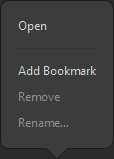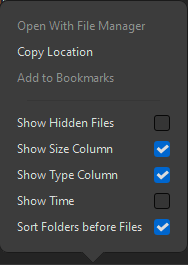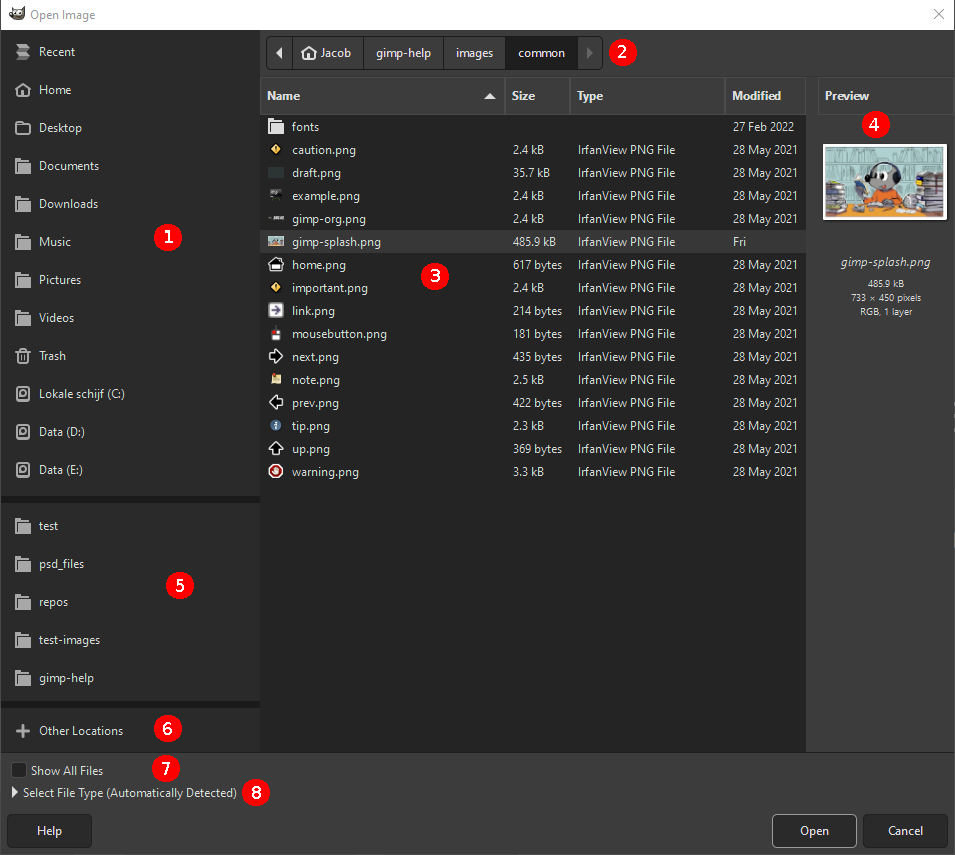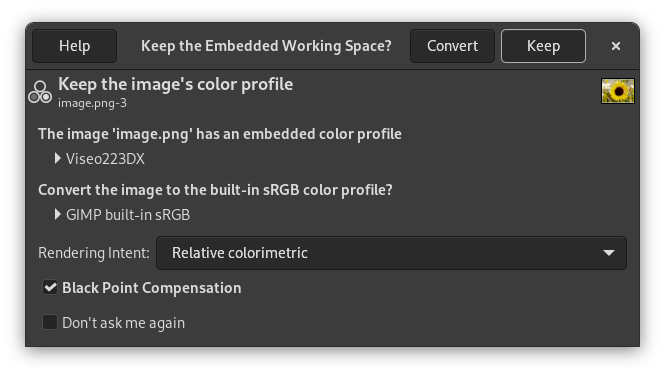De volgende pagina's documenteren de dialoogvensters voor het openen, opslaan en exporteren van uw afbeeldingen.
Het dialoogvenster laat u een afbeelding selecteren om te worden geladen vanaf uw harde schijf of een extern apparaat.
-
Toegang tot het dialoogvenster uit het menu via: → .
-
U kunt het dialoogvenster ook openen met de sneltoets Ctrl+O.
Dit dialoogvenster voor het selecteren van een bestand zou er bekend uit moeten zien als u eerder met bestanden hebt gewerkt. Onthoud dat, afhankelijk van uw besturingssysteem, er enkele verschillen zouden kunnen bestaan in de wijze hoe dit dialoogvenster eruit ziet. We zullen de details van dit dialoogvenster uitleggen, gebaseerd op de cijfers in de rode cirkels.
-
Dit gebied geeft u toegang tot uw hoofdmappen en uw apparaten voor opslag. De eerste keer als u dit dialoogvenster na het opstarten van GIMP, zal Onlangs gebruikt hier geselecteerd zijn. Dat is een speciale map die de afbeeldingen laat zien (zie 3) die u recent in GIMP hebt geopend.
Naast de map Onlangs geopend vindt u hier uw map Home, mappen naar uw documenten, afbeeldingen en andere speciale locaties, als ook uw harde schijven, externe schijven en gedeeld netwerk. Met links klikken op een van deze mappen zal die selecteren als de huidige map en de lijst met afbeeldingen in het gebied van de lijst met afbeeldingen bijwerken (3).
Door met rechts te klikken op een map in deze lijst zal een contextmenu openen. Niet alle opdrachten zullen altijd beschikbaar zijn, of ingeschakeld. Hetzelfde contextmenu wordt ook weergegeven in de lijst met mappen voor bladwijzers, bekijk (5).
 Het contextmenu van de lijsten met mappen en bladwijzers
Het contextmenu van de lijsten met mappen en bladwijzers- Openen
-
Dit opent de inhoud van de geselecteerde map in het venster van de lijst met afbeeldingen (3).
- Bladwijzer toevoegen
-
Dit stelt u in staat de geselecteerde map als een bladwijzer toe te voegen. Bladwijzers worden weergegeven in het gebied dat is gemarkeerd als (5).
- Verwijderen
-
Dit stelt u in staat een bladwijzer te verwijderen. Het is uitgeschakeld voor andere mappen en apparaten.
- Hernoemen…
-
Dit stelt u in staat een bladwijzer, of bepaalde speciale mappen, te hernoemen. Onthoud dat het alleen de bladwijzer of de speciale map, zoals die wordt weergegeven binnen het dialoogvenster voor bestandskeuze, hernoemt, niet de feitelijke map waar het naar verwijst.
-
Standaard laat dit het pad naar de huidige map zien. U kunt naar een van de oudermappen navigeren door te klikken op het gewenste deel.
Als alternatief, kunt u de naam van een afbeelding invoeren. Zodra u begint met typen, zal d lijst met afbeeldingen (3) alleen die weergeven die de lettercombinatie bevat die u hebt ingevoerd.
Als u moet navigeren naar een andere locatie die niet beschikbaar is met klikken, kunt u een tekstveld openen, waar u de gewenste locatie kunt typen of plakken. Gebruik om daar te komen Ctrl+L, en druk, nadat u de locatie hebt ingevoerd, op Enter.
![[Opmerking]](images/note.png)
Opmerking U kunt dit invoerveld voor locatie gebruiken om de inhoud van een andere map weer te geven, door de locatie van een map in te voeren; of een specifieke afbeelding openen door het volledige pad naar de afbeelding in te voeren.
-
De inhoud van de geselecteerde map wordt hier weergegeven. Wijzig uw huidige map door te dubbelklikken met links op een map in dit paneel. Selecteer een bestand met een enkele klik links. U kunt dan het bestand openen dat u hebt geselecteerd door te klikken op de knop . Een dubbelklik met rechts opent het bestand direct. Onthoud dat u alleen afbeeldingsbestanden kunt openen.
Standaard wordt de lijst met afbeeldingen alfabetisch gesorteerd, gebaseerd op de bestandsnamen van de afbeeldingen. De namen van de kolommen boven de lijst met afbeeldingen kan worden gebruikt om te selecteren hoe u de lijst gesorteerd wilt hebben. Klikken op een kolom zal die kolom gebruiken om de lijst te sorteren. Een kleine driehoek aan de rechterkant, naast de naam, geeft aan dat het momenteel wordt gebruikt om de lijst te sorteren. Als het driehoekje naar boven wijst, wordt oplopend gesorteerd. Opnieuw klikken op dezelfde kolom zal de sorteervolgorde wijzigen naar aflopend en het driehoekje zal naar beneden wijzen.
Met rechts klikken op een afbeelding of map in deze lijst opent een contextmenu:
 Het contextmenu van de lijst met afbeeldingen
Het contextmenu van de lijst met afbeeldingen- Openen met bestandsbeheer
-
Dit is alleen ingeschakeld voor mappen. Indien ingeschakeld kunt u de geselecteerde map openen in de standaard bestandsbrowser op uw computer. Opmerking: deze opdracht werkt momenteel niet op Windows.
- Locatie kopiëren
-
Dit kopieert de locatie van het geselecteerde bestand naar het klembord.
- Toevoegen aan bladwijzers
-
Dit stelt u in staat de geselecteerde map als een bladwijzer toe te voegen. Bladwijzers worden weergegeven in het gebied dat is gemarkeerd als (5). Dit is uitgeschakeld als u een bestand hebt geselecteerd in plaats van een afbeelding.
- Verborgen bestanden tonen
-
Indien ingeschakeld zullen verborgen bestanden worden weergegeven in de lijst met afbeeldingen (3).
- Kolom Grootte tonen
-
Indien ingeschakeld zal de grootte van elke afbeelding worden weergegeven in de lijst met afbeeldingen (3).
- Kolom Type tonen
-
Indien ingeschakeld zal het bestandstype van elke afbeelding worden weergegeven in de lijst met afbeeldingen (3).
- Tijd tonen
-
Indien ingeschakeld zal de tijd van wijzigen worden weergegeven in de lijst met afbeeldingen (3), in aanvulling op de wijzigingsdatum.
- Mappen vóór bestanden sorteren
-
Indien ingeschakeld zullen eventuele in de geselecteerde map aanwezige mappen worden weergeven aan de bovenkant van de lijst met afbeeldingen (3). Indien uitgeschakeld zullen de mappen worden gemixt met de afbeeldingsbestanden, gebaseerd op de geselecteerde kolom voor sorteren.
-
Een miniatuurversie van de geselecteerde afbeelding in de lijst met afbeeldingen (3) wordt weergegeven in het venster Voorbeeld aan de rechterkant. Als het een indeling voor afbeeldingen is die wordt herkend door GIMP, worden bestandsgrootte, dimensies en samenstelling van de afbeelding weergegeven onder het voorbeeldvenster.
![[Tip]](images/tip.png)
Tip Als uw afbeelding werd gewijzigd, maar de miniatuur werd niet bijgewerkt, kunt u op de afbeelding van Voorbeeld klikken om de miniatuur bij te werken. Gebruik Ctrl + klik om het bijwerken van de miniatuur af te dwingen voordat die zelfs maar werd gewijzigd.
-
Dit deel van de lijst geeft de mappen weer die u als bladwijzers hebt gemarkeerd. U kunt bladwijzers toevoegen met de optie Toevoegen aan bladwijzers die wordt weergegeven als u met rechts klikt op een map in het paneel van de lijst met afbeeldingen (3).
U kunt een bladwijzer verwijderen door de opdracht Verwijderen te gebruiken die wordt weergegeven als u met rechts klikt op een bladwijzer. Dit menu voor rechtsklikken kan ook worden gebruikt om de bladwijzer te Hernoemen…. Hernoemen van de bladwijzer wijzigt niet de naam van de map waar hij naar verwijst.
-
Door te klikken op het label Andere locaties zal een lijst met andere bekende locaties en apparaten op uw computer openen in het paneel van de lijst met afbeeldingen. U kunt dat gebruiken voor gemakkelijke toegang tot bepaalde locaties op uw computer, die niet direct beschikbaar zouden kunnen zijn in de lijst met mappen aan de linkerkant.
-
De optie Alle bestanden tonen is gewoonlijk niet geselecteerd. Als u deze optie selecteert, zullen alle bestanden in de geselecteerde map worden weergegeven, in plaats van alleen de afbeeldingsbestanden die GIMP herkent.
-
Bestandstype selecteren kan worden gebruikt om de indeling van het afbeeldingsbestand expliciet in te stellen. Het is een keuzelijst die de indelingen voor afbeeldingsbestanden weergeeft die GIMP herkent. Over het algemeen hoeft u zich hier geen zorgen om te maken, omdat GIMP in de meeste gevallen het bestandstype automatisch kan bepalen.
Standaard is Automatisch opgemerkt, wat ervoor zorgt dat GIMP probeert om de juiste indeling automatisch te detecteren.
In enkele uitzonderlijke gevallen waarbij noch de bestandsextensie, noch de interne informatie in het bestand voldoende zijn om GIMP het bestandstype te vertellen, kunt u dit instellen door het in de lijst te selecteren.
![[Tip]](images/tip.png)
Tip Expliciet selecteren van het bestandstype kan in bepaalde gevallen nuttig zijn. U kunt dit bijvoorbeeld doen om expliciet de samengevoegde afbeelding van Photoshop te laden als die is opgeslagen als een afbeelding PSD (indien aanwezig). Omdat afbeeldingen van Photoshop niet altijd correct worden geladen in GIMP, stelt dit u in staat de afbeelding te bekijken zoals dat werd bedoeld door Photoshop.
-
Met Zoeken kunt u zoeken naar een bestand of map, zelfs als u niet de exacte naam weet. Klik op Zoeken, type een bestandsnaam of slechts een deel van een naam in het zoekvak en druk op Enter. Het gebied voor het weergeven van bestanden (7) zal dan alle bestanden en mappen vermelden van uw map Home (gebruikersmap op Windows) met namen die de tekst bevatten waarnaar u zocht.
Onlangs gebruikt geeft de lijst met bestanden weer die u recent hebt geopend.
Wanneer u een niet XCF-afbeelding opent waaraan een kleurprofiel is gekoppeld, zal GIMP een dialoogvenster openen dat u vraagt of u het originele profiel wilt behouden, of het wilt converteren naar het ingebouwde sRGB-kleurprofiel van GIMP.
Hoewel we over het algemeen aanbevelen om het kleurprofiel te behouden, is het gebruiken van beide keuzes prima, omdat GIMP een conversie van het profiel op de achtergrond zal uitvoeren als dat nodig is.
![[Tip]](images/tip.png)
|
Tip |
|---|---|
|
Als u wilt dat GIMP stopt met het stellen van deze vraag, klik dan op de optie Niet opnieuw vragen. Als u van mening verandert, kunt u altijd de vraag terugzetten door te gaan naar Voorkeuren, Kleurbeheer, Beleid, Gedrag bij openen van bestanden. |





